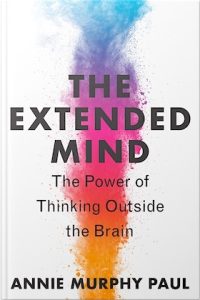 By Cathy Gassenheimer
By Cathy Gassenheimer
Executive Vice President
Alabama Best Practices Center
Is it possible to think outside of the brain? Science journalist Annie Murphy Paul thinks so and builds her case in a fascinating new book entitled The Extended Mind: The Power of Thinking Outside the Brain, which carries the intriguing tagline: “It’s the stuff outside your head that makes you smart.”
UPDATE: Find time to listen to some or all of this wonderful hour-long video chat with Adam Grant and Annie Paul. Just click!
Some of you may be familiar with Paul, who regularly writes about issues that relate to education. Her website chronicles her writing for The New York Times, Scientific American, and many other publications and is full of excerpts and ideas from her new book, which has received rave reviews from a diverse group of thought leaders – ranging from Adam Grant and Susan Cain to Doug Lemov, Howard Gardner and Amanda Ripley.
 “Annie Murphy Paul has written a book that will help teachers and parents to get the most out of school. The Extended Mind is not just a fascinating read, firmly grounded in science—it will help you, and your students and your children, to think better.”—Daniel Willingham, University of Virginia psychologist and author of Why Don’t Students Like School?
“Annie Murphy Paul has written a book that will help teachers and parents to get the most out of school. The Extended Mind is not just a fascinating read, firmly grounded in science—it will help you, and your students and your children, to think better.”—Daniel Willingham, University of Virginia psychologist and author of Why Don’t Students Like School?
The Book’s First Line is Telling
Paul begins her book with a statement we’ve heard often or even used ourselves: “Use your head.” But by the third paragraph, she blows up that notion with this sentence: “As it is, we use our brains entirely too much.”
WHAT? How can we use our brains too much? Before I slammed the book closed without reading more than the prologue and first page, I took a deep breath and read on. As I read, I learned that Paul isn’t against using our brains (impossible, of course!), she just wants us to think outside of the brain more often.
What does that mean? Here’s her succinct summary:
“Thinking outside of the brain means skillfully engaging entities external to our heads—the feelings and movements of our bodies, the physical spaces in which we learn and work, and the minds of other people around us—drawing them into our out mental processes.
By reaching beyond the brain to recruit these ‘extra-neural’ resources, we can focus more intently, comprehend more deeply, and create more imaginatively—to entertain ideas that would literally be unthinkable by the brain alone.” (pp. 1-2)
Okay, I thought. I can work with that.
Getting Started: Extra-Neural Resources

Our body is a great extension to our brain, according to Paul. She reminds us of our intuition or what is called interoception, which simply involves our being aware of “the inner state of our body.” Tuning in to our heartbeat, our breathing, and other extra-neural bodily functions that impact our emotions can help us make wiser choices.
Our choices improve when we take the time to “name” those feelings we’re experiencing. When we give what we are feeling a name, it can help us both recognize and “dial down” whatever stress response we are feeling. If you are a ruminator like I am, taking the simple action of labeling it – I’M RUMINATING NOW – will help you move forward without obsessing about something that you can’t change.
Movement Can Improve Your Thinking
The pandemic has shown many of us the value of movement when we’re stuck or mentally frustrated. When we exercise or even take a short walk, our mental capacity improves. More educators are embracing brief “movement breaks,” and there appears to be a resurgence in recreational breaks for all ages to help students’ brains recover from the mental stress of sitting and listening for long periods of time.
Movement doesn’t just have to be limited to our feet. Gesturing is important as well. In the study guide accompanying the book, Paul refers to research that “moving our hands advances our understanding of abstract or complex concepts.” Think about a time you’ve grappled with a concept. Chances are, you were using your hands to try to figure it out. If you “talk with your hands,” you are in good company. Experts use gestures all the time to figure out complex problems!
Thinking and Mother Nature
The pandemic also provided an opportunity for many of us to spend more time outdoors experiencing the natural world. Being outside or even seeing photos of pastoral settings can help recharge the brain. This concept isn’t new. Paul calls upon the words of Frederick Olmstead, the landscape architect who designed Central Park:
“Natural scenery employs the mind without fatigue and yet enlivens it; and thus, through the influence of the mind over the body, gives the effect of refreshing rest and reinvigoration to the whole system.”
The mind is also boosted when working in a building designed to bring nature inside or offer light and open spaces. Jonas Salk, the creator of the polio vaccine, understood the importance of open spaces. When stuck trying to develop the formula, he traveled to the Basilica of Saint Francis of Assisi, to clear his mind. Upon return, he was able to finish the formula. Recognizing the importance of building to productive and creative thinking, he created a space for others to experience. Check out the photos of the Salk Institute in La Jolla, California.
Students: Thinking With Experts
The last part of the book really speaks to both student and adult learning. For example, Paul suggests that apprenticeship is another way to extend the mind. Paul calls upon Allan Collins, a professor emeritus at Northwestern University who coined the phrase “cognitive apprenticeship” and its four features, somewhat similar to the gradual release of responsibility:
- Modeling
- Scaffolding
- Fading (gradually withdrawing guidance as the learner becomes more proficient)
- Coaching
Imitation is also a way to extend the mind. As an example, Paul refers to Ron Berger, co-author of Leaders of Our Own Learning and a friend of the Alabama Best Practices Center, who holds a strong belief in exemplars. (If you’ve not watched the short film where Ron works with a group of elementary students to create a scientific drawing of a butterfly, take a few minutes to enjoy the video.)
By advocating imitation Paul and Berger are not suggesting plagiarism. Rather, they believe showing students and adults exemplary work can inspire them and serve as a model for excellence. As Berger notes in The Extended Mind: “How can we expect students to produce first-rate work when they have no idea what first-rate work looks like?” (p. 179).
Thinking With Peers: Arguing and Storytelling
 As a former high school debater, I embrace the view of Robert Sutton, one of the creators of the Knowing-Doing Gap concept, on arguing, He suggests that we “offer strong opinions, weakly held” or “fight as if they are right and listen as if they are wrong” (p. 204)
As a former high school debater, I embrace the view of Robert Sutton, one of the creators of the Knowing-Doing Gap concept, on arguing, He suggests that we “offer strong opinions, weakly held” or “fight as if they are right and listen as if they are wrong” (p. 204)
Storytelling can also extend the mind. We tend to relate more to stories, remember them better, and understand more than we do when we simply reading a text. Paul gives two examples of a description of radioactive elements and the work of Marie Curie. The first is a boring excerpt from a middle school science textbook while the second reads more like an action movie with facts. An excerpt from the second version:
“By the late 1800s, scientists had already found most of elements, but some were yet to be discovered. At this time, Polish-born Marie Curie and her French husband, Pierre, were two chemists living in France, trying to find all the Earth’s natural elements. Although it was very hard detective work, Marie and Pierre loved solving the mysteries of the elements. One day, a fellow scientist named Henri Becquerel showed Marie and Pierre a special kind of rock called pitchblende. When Henri took this pitchblende rock into a dark room, Marie could see that it gave off a light blue glow…” (p. 205)
The second version captivated me and I found myself instantly more interested! I was disappointed when the excerpt ended and wanted to learn more. Chances are I’ll remember the story of the light blue glow and worry about the lasting impact on Curie’s health!
Networking and Extending Our Learning
While Stoney Beavers and I refer to the work we are doing as networked learning, Paul refers to it as “entitativity” or “groupiness.” Whatever the name, structured network learning can enhance thinking and extend the mind. Paul identifies four important principles to “groupiness”:
- People who need to think together should learn together.
- People who need to think together should train together.
- People who need to think together should feel together (share emotional experiences).
- People who need to think together should engage in rituals together. (pp.224-226)
In a recent tweet, Paul noted a teacher’s use of collective retrieval practice, comparing it to ‘shared remembering.’
Teacher Sarah Jones @JonesLearnUK says she uses in-class retrieval practice "because it builds the collective memory and experience of the class—part of the narrative of ‘what we all have done and know.'"
Love that. Shared retrieval practice is effectively shared remembering.
— Annie Murphy Paul (@anniemurphypaul) October 24, 2021
It’s interesting how all of these research findings we’re hearing about group learning seem to swirl around a central core – the idea that often “the whole is greater than the sum of the parts.”
Only the Tip of the Iceberg
There is so much more included in The Extended Mind. If this short review has piqued your interest, I hope you’ll get the book and spend some time with it yourself. You can also subscribe to Annie Murphy Paul’s occasional newsletters.
And, after a long day of teaching, or reading, or doing some brain-taxing task, try some of these tips. You just might find that you’ve extended your mind!
Resources
Middle School Walk & Talk – AMLE’s podcast series hosted by author & school counselor Phyllis Fagell and MS principal Joe Mazza features an August interview with Annie Paul, zeroing in on applications of her research in classrooms and schools. At the AMLE website, at Apple Podcast, and all major podcast platforms. (20 min.)
Saving Salk’s Mystery – If you’re an architecture buff, you might enjoy this long-read about architect Louis Kahn’s work at the Salk Institute and his other open-space, outside-the-brain designs, like the Margaret Esherick House in Philadelphia (below).


0 Comments on "The Extended Mind: “The Stuff Outside Your Head Makes You Smart”"